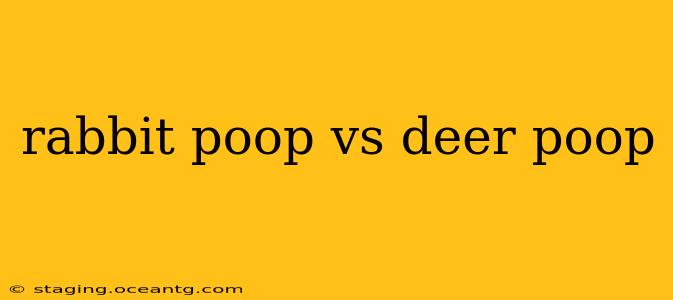Identifying animal scat can be a fascinating and useful skill, whether you're a keen naturalist, a gardener trying to understand your visitors, or a hunter tracking prey. Two frequently encountered droppings are those of rabbits and deer. While both are herbivores, their droppings differ significantly in size, shape, and composition. This comprehensive guide will help you confidently distinguish rabbit poop from deer poop.
What does rabbit poop look like?
Rabbit droppings are small, round, and generally dark brown to black in color. They are typically about ¼ inch in diameter and have a fairly uniform consistency. Fresh rabbit droppings are often moist and slightly shiny, while older droppings become drier and harder. Unlike some animals, rabbits produce two types of droppings:
- Hard pellets: These are the typical droppings described above, primarily composed of partially digested plant material.
- Caecal pellets (cecotropes): These are soft, dark, and often slightly sticky droppings. Rabbits consume these directly from their anus for further digestion, allowing them to extract more nutrients from their food. You are less likely to see these unless you're observing rabbits very closely.
Rabbits often deposit their droppings in specific locations, sometimes creating "middens" or piles of scat.
What does deer poop look like?
Deer droppings are considerably larger than rabbit droppings, often ranging from ½ to 1 inch in diameter. They are typically oval or cylindrical in shape and usually dark brown or black. The consistency varies depending on the deer's diet and hydration. Fresh deer droppings may be soft and moist, while older droppings become dry and crumbly. They often contain partially digested plant matter, seeds, and bits of twigs.
Unlike rabbits, deer typically scatter their droppings more randomly, rather than forming concentrated piles.
How to tell the difference between rabbit and deer poop?
The most significant difference lies in size and shape. Rabbit droppings are consistently small and round, whereas deer droppings are significantly larger and more oval or cylindrical. Look for the size difference—a visual comparison is usually enough to distinguish between the two.
What is the size and shape of rabbit and deer droppings?
As mentioned above, rabbit droppings are small (¼ inch diameter) and round, while deer droppings are larger (½ to 1 inch diameter) and oval or cylindrical. This size difference is the most reliable characteristic for identification.
What does the consistency of rabbit and deer droppings indicate?
The consistency of both can range from moist and fresh to dry and hard depending on the animal's diet, hydration, and the age of the droppings. Fresh droppings are usually softer and darker. Older droppings will be drier and may have a lighter coloration.
Where do rabbits and deer typically defecate?
Rabbits tend to create distinct piles or "middens" of their droppings, often in sheltered or hidden areas. Deer, in contrast, scatter their droppings more widely and randomly within their home range.
Are there any other ways to identify rabbit and deer droppings?
While size and shape are the primary identifiers, the presence of partially digested plant material and the surrounding environment can offer additional clues. The presence of other animal tracks or signs can also aid in identification.
Conclusion
Distinguishing rabbit poop from deer poop is relatively straightforward once you understand the key differences in size, shape, and typical deposition patterns. Remember to always prioritize safety when observing wildlife and their droppings. Observing animal scat is a fascinating way to learn about the local ecosystem and the animals inhabiting it. By carefully analyzing the characteristics of the droppings, you can become proficient in identifying different animal species and understanding their habits.
